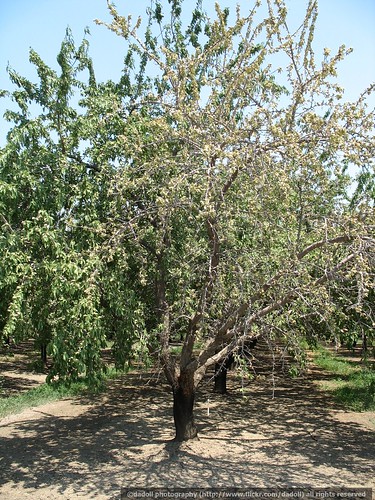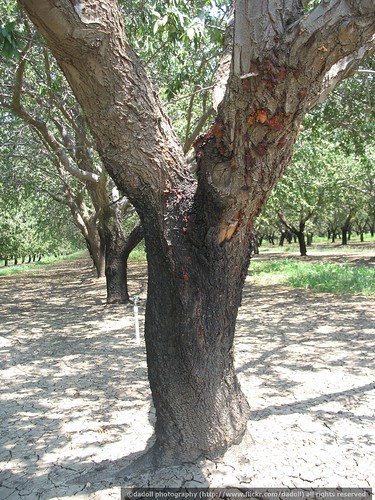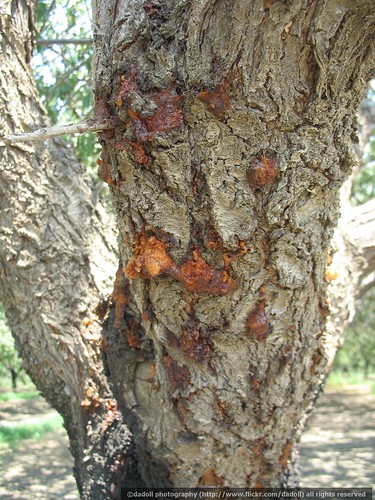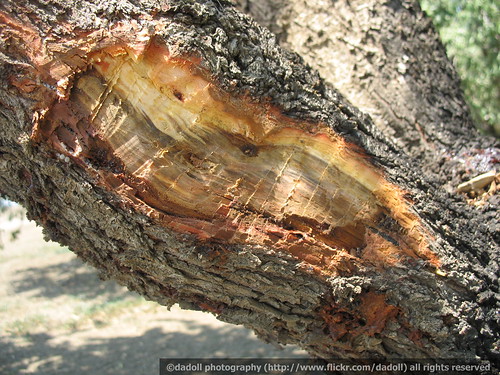
Ceratocystis or “mallet wound canker” has been found on almond throughout California for almost 50 years. This fungal canker, caused by Ceratocystis fimbriata, can develop on areas of the trunk or branches that have been damaged by tractors, hedgers, and harvesting equipment. Pruning wounds are also susceptible. Cultivars that are most susceptible include Nonpareil, Mission, and Ne Plus Ultra.
Ceratocystis cankers appear as either water soaked or dry cankers. Amber-colored gum is found at the canker margins. Infected tissue turns brown and the area eventually becomes sunken. Unlike Phytophthora infections, Ceratocystis remains active during the summer months in which rapid canker growth can occur. Cankers can girdle limbs, scaffolds, and tree trunks.Limbs 4-6 inches in diameter have been observed to be girdled in 3-4 years, while smaller branches are killed more quickly.

Ceratocystis cankers appear as either water soaked or dry cankers. Amber-colored gum is found at the canker margins. Infected tissue turns brown and the area eventually becomes sunken. Unlike Phytophthora infections, Ceratocystis remains active during the summer months in which rapid canker growth can occur. Cankers can girdle limbs, scaffolds, and tree trunks.Limbs 4-6 inches in diameter have been observed to be girdled in 3-4 years, while smaller branches are killed more quickly.
Several species of sap-feeding beetles and fruit flies spread Ceratocystis. These insects feed on the fungus, ingesting and coming into bodily contact with the spores. The spores are then transported to other trees and deposited on the bark by the insects. Rains and sprinkler irrigations can wash the spores into fresh pruning wounds or other injuries. Once the fungus infects the cambium, it will begin to invade the healthy bark and xylem tissues of the tree. Dark stains may permeate into the heartwood of the tree, but rarely is the fungus found in these tissues.

Ceratocystis cankers can be avoided by preventing shaker damage on trunks and scaffolds. If the bark is injured, shave the damaged portions to promote callus formation. Wounds may be treated with thiophanate-methyl which has been shown to reduce fungal infection (Follow label specifications). If planning to cover the wound with paint, acrylic paint is recommended at this time – do not use tree-seal. Avoid pruning before any rainy weather. Following bark injury, trees are susceptible to Ceratocystis infections for 8-14 days.

Established cankers can be surgically removed. Remove infected bark and 1/4 – 1/2 inch of the woody tissue underneath the bark. The cut should extend one inch beyond the canker margin. Limbs that have been killed by the enlarging canker should be removed by cutting six inches below the canker margin. Branch removal and surgery should occur during December-February when the pathogen and vector insects are less active. Attempts to remove cankers may be unsuccessful, in which case the fungus may continue to grow. Affected trees should be rechecked the following year, and the surgical process repeated if survival of the canker has occurred. Dressing of pruning or surgical wounds made during the winter is not needed as most vectors are inactive at this time.
Orchards severely infested by Ceratocystis have typically been damaged repeatedly by harvesters. Proper equipment usage in order to prevent tree injury will reduce the incidence of the disease.

